Understanding the types of services in the food and drink industry is really important as the customer’s dining experience and restaurant success depends on it.
This article explores different types of food and beverage services and how they play an important role in restaurants, cafes, and hotels.
Get ready to learn about lots of different services. From fancy to more relaxed, each one has its own special feeling and style. Whether you own a restaurant, work in the food industry, love trying new foods, or just want a unique dining experience, there’s something here for everyone.
We’ll show you how eating out at a restaurant is an effective mix of great service and food that makes people want to come back. So let’s start exploring all the different types of services in the food and beverage industry!
Main types of food and beverage services that we are going to take a look at are:
- Formal Dining Services
- Waiter Services
- Assisted Services
- Self-Service
- Special Services
1. Formal Dining Services
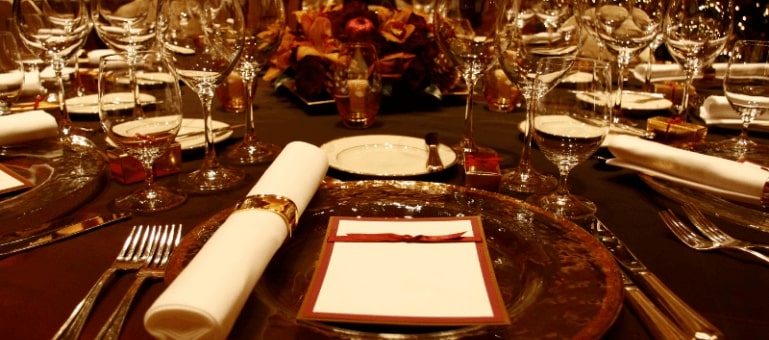
Formal dining services are a sophisticated style of restaurant experience where manners, attention to detail, and a refined ambiance combine to create a memorable dining experience.
This type of dining is often characterized by well-dressed staff, fine table settings, and a carefully curated menu that showcases culinary expertise.
Formal dining focuses on providing a high level of service and creating a luxurious atmosphere for diners. Dishes are expertly prepared and presented, and the staff is trained to cater to the guests’ every need, ensuring a seamless and enjoyable dining occasion.
Customers who opt for formal dining services are looking for a luxurious experience, often for special occasions. Formal dining aims to offer a sense of luxury and indulgence, where every aspect of the dining experience contributes to a sense of elegance and refinement.
Fine Dining

Fine dining services offer an elegant style of dining that focuses on creating a luxurious and memorable experience for customers. This type of dining is all about attention to detail, exceptional service, and a carefully curated menu that showcases culinary excellence.
In fine dining, customers can expect top-notch service from well-trained staff, sophisticated table settings, and an atmosphere that reflects luxury. The menu often features high-quality ingredients and creative dishes that highlight the chef’s skill.
The goal of fine dining is to provide a sense of sophistication, where every element of the meal – from the food’s presentation to the restaurant’s ambiance – contributes to a sense of style.
Table Service

Table service refers to the way food and beverages are served to customers at a restaurant or dining establishment. It involves the interaction between the waitstaff and the diners, ensuring that they have a pleasant and satisfying dining experience.
In table service, the waitstaff takes orders, serves food and drinks, and attends to the needs of the customers throughout their meals. This can include setting the table, presenting the menu, taking orders, delivering meals, refilling drinks, and clearing away empty plates and glasses.
Table service aims to provide personalized care to diners, creating a comfortable and enjoyable environment. It enhances the overall dining experience by offering convenience and promptly meeting customers’ needs.
2. Waiter Services

Waiter services encompass a variety of dining experiences characterized by personalized, tableside service. With a focus on attentive, professional waitstaff, these services ensure a memorable and enjoyable dining experience.
Waiters play a pivotal role in guiding diners through the menu, taking orders, serving dishes, and attending to their needs throughout the meal. Whether it’s the classic charm of French service or the interactive experience of Gueridon service, the common thread in waiter services is the dedication to providing top-notch hospitality and enhancing the overall enjoyment of dining in a restaurant.
Waiter service is further classified into the following 5 service types.
English Service
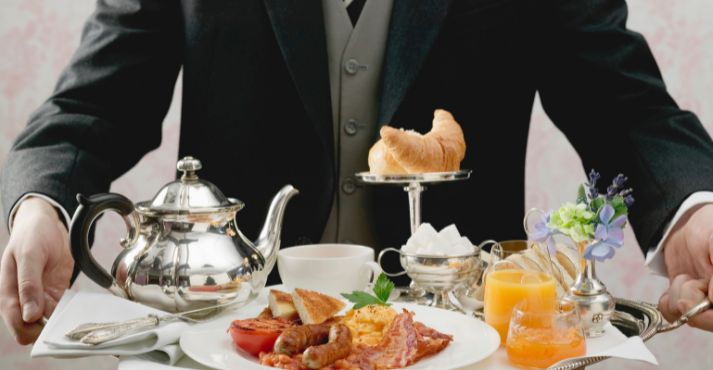
Known as “à la russe,” this is the most formal of all service styles. In this service style, each course is individually presented to diners by the server. Food is served from the left, and empty dishes are discreetly cleared from the right. This level of precision and attentiveness ensures a high degree of guest interaction, making it particularly well-suited for upscale dining establishments and formal events.
What sets English Service apart is the personal touch it adds to the dining experience. The server takes on a more prominent role, engaging with guests as they serve each course. This interactive element, combined with the elegance and attention to detail, creates a dining atmosphere that is truly memorable and reflective of fine dining traditions. English Service is reserved for special occasions and venues where impeccable service is paramount.
American Service
This type of waiter service offers a balanced approach to dining, striking the perfect chord between formality and casual elegance. In this style of food service, the dishes are prepared and plated in the kitchen. The server then brings the fully assembled dishes to the table and presents them to the guests, typically from the left side.
What sets American Service apart is its relaxed yet engaging approach. Unlike the intricate formality of English Service, it provides guests with a comfortable and inviting dining experience. Diners can savor their meals without the fuss of individual plating, while still enjoying the personalized presentation by the server.
American Service is commonly found in a variety of dining establishments, ranging from mid-range to upscale restaurants. It caters to those who seek a tasteful dining experience that combines the convenience of pre-plating with the charm of tableside service, making it a popular choice for both formal and more relaxed dining occasions.
French Service
French Service, renowned for its elegance, elevates the dining experience to a sophisticated and communal affair. In this style, the food is presented uniquely – all the dishes are artfully arranged on a sideboard or a separate table within the dining area, allowing guests to serve themselves. However, what distinguishes French service is the server’s involvement in the plating process. They add finishing touches, garnishes, and sometimes, rich sauces to the dishes at the table.
This style of service creates an atmosphere of shared dining, akin to a family gathering. Guests can enjoy the pleasure of serving themselves while being graced with the attention of a skilled server who refines the presentation. French service is a perfect choice for those who relish a communal dining experience but with an air of sophistication and the added touch of tableside service.
Russian Service
It is a refined style of dining service that emphasizes precision and uniformity in presentation. In this method, the food is meticulously plated in the kitchen by the culinary team and is then elegantly served directly onto the guests’ plates. The dishes are pre-portioned, ensuring that each guest receives an identical and visually appealing presentation.
This style of service is characterized by its consistency and the assurance that every guest will enjoy a uniform culinary experience. The attention to detail in plating and portioning showcases the commitment to visual and culinary consistency. Russian Service is often found in upscale dining establishments and formal settings, where guests can expect a high degree of precision and artistry in the presentation of each dish, making it a popular choice for those who appreciate attention to detail and culinary finesse.
Gueridon Service
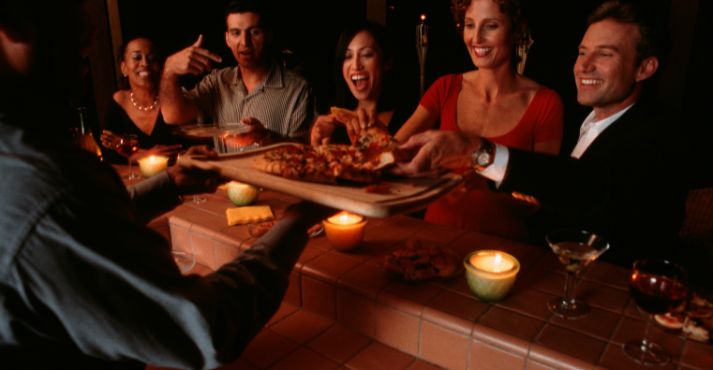
Gueridon service is a captivating and interactive dining experience that adds an element of theater to the restaurant setting. It involves the use of a specialized service trolley or gueridon to prepare, finish, or present dishes tableside, right in front of the guests. This service style often includes exciting activities such as salad tossing, carving, flambéing, dessert preparation, or even wine decanting.
The trolley is equipped with various tools, ingredients, and equipment needed to complete the dish, making it an engaging spectacle for diners. Theatrical and visually appealing, Gueridon Service enhances the overall dining experience by providing entertainment and allowing guests to be a part of the culinary process.
This style of service is typically found in upscale and fine dining establishments where the performance aspect of dining complements the gourmet experience. It creates a memorable and interactive atmosphere, leaving diners with a lasting impression of their culinary journey.
3. Assisted Services
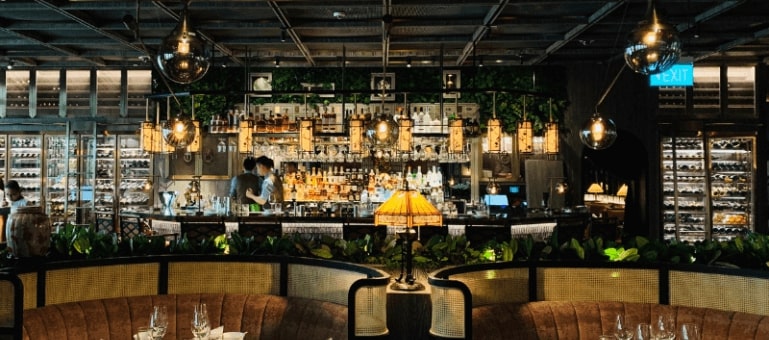
Assisted service in the context of food and beverage revolves around a unique dining experience where guests actively participate in aspects of their meal service.
This hands-on approach often includes elements like self-serving dishes from a buffet or making selections from a diverse spread in a lounge setting. Unlike traditional waiter service, where the staff takes charge of serving, assisted service empowers diners to engage with their food choices.
It’s an informal yet engaging style that encourages exploration and customization of the dining experience, making it a popular choice for casual settings and events where interactive, communal dining is appreciated.
This is where customers can experience experimental cuisines such as plant-based alternatives and alternative protein options.
Assisted services are further classified into the following types.
Buffet Service
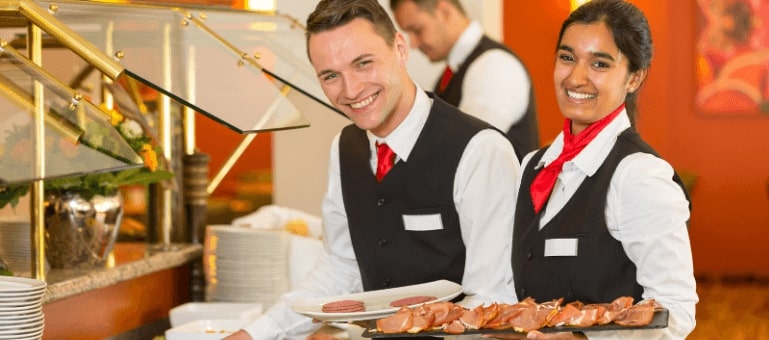
Buffet dining services offer a self-service approach to enjoying a meal. In this style of dining, a variety of dishes are displayed on long tables or counters, and customers can help themselves to the food they prefer.
Buffets provide a wide range of options, from appetizers to main courses and desserts. This setup is popular for its flexibility, as diners have the freedom to customize their plates and try different dishes without having to wait for each course to be served.
In buffet dining, customers usually pay a fixed price and can enjoy unlimited servings of the available dishes. The atmosphere is often relaxed and casual, making it suitable for various occasions, including parties, events, and gatherings.
Lounge Service
Often found in lounges, bars, and casual eateries, lounge service maintains the relaxed ambiance of self-service. Lounge Service is characterized by its flexibility, making it ideal for individuals looking for a quick bite or a relaxed atmosphere to unwind.
In Lounge Service, guests can choose from a menu that typically includes a variety of finger foods, small plates, and drinks. This style of service is designed to cater to diners who want to enjoy a casual and convenient dining experience without the formality of a full-service restaurant.
Lounge Service is particularly well-suited for social gatherings, solo travelers, or those seeking a place to work or relax. It allows guests to enjoy their food and drinks at their own pace, making it a popular choice in locations where diners have different schedules or preferences. The key to successful Lounge Service is attentive staff, an inviting ambiance, and a menu that offers a range of options to cater to diverse tastes.
4. Self-Service
Self-service represents a dining approach where restaurant guests actively participate in various aspects of their meal experience. This includes tasks like selecting their food, retrieving beverages, and even clearing their table.
Self-service can be found in settings like cafeterias or establishments with a single-point service counter, such as fast-food restaurants. This approach offers customers a degree of control and convenience, making it a popular choice for those seeking quick and efficient dining. By taking on these responsibilities, diners can tailor their experience to their liking and pace, adding an element of autonomy to their meal.
Self-services are further classified into the following types.
Cafeteria Service
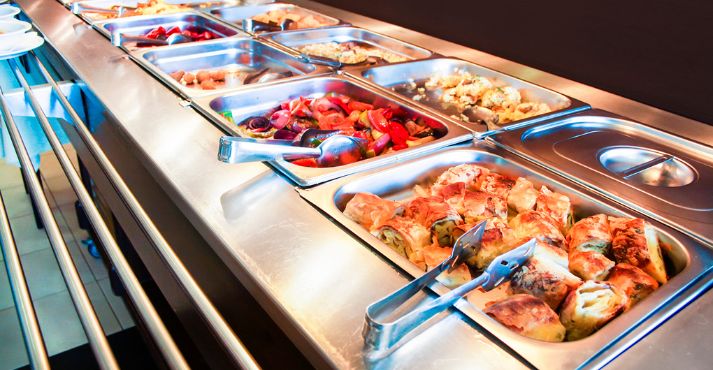
Cafeteria service is a self-service style commonly employed in institutions like schools, hospitals, and corporate settings. It’s characterized by a layout where food is presented behind a serving counter, and customers serve themselves, moving along the counter to select the items they desire. This type of service is known for its efficiency and cost-effectiveness.
In a cafeteria, guests have the freedom to choose from a variety of pre-prepared dishes, usually displayed in a line or buffet-style setup. The diverse selection can include main courses, sides, salads, and desserts, offering a wide range of options to accommodate different tastes and dietary preferences.
Cafeteria service is particularly popular in places where large groups of people need to be served quickly. It’s a practical choice for organizations or institutions because it minimizes wait times and streamlines the dining process. The success of Cafeteria Service relies on maintaining food quality, cleanliness, and an organized flow to ensure a positive dining experience for all guests.
Single Point Service

Single point service, often seen in casual and fast-food settings, simplifies the dining experience for customers. Unlike the more elaborate styles of table service, it involves a straightforward process where customers place their orders at a designated counter, pay, and then receive their meals. This method is efficient, particularly when there’s a high volume of customers.
At a single point service establishment, the menu is usually displayed overhead or on menu boards behind the counter. Customers line up, make their selections, and interact with the cashier or attendant to place their orders. After paying, they typically receive a number or order ticket, which is used to identify their table or location. Once their food is prepared, it’s either brought to their table or picked up from another designated point when their number is called.
This type of self-service is well-suited for fast-paced environments, as it minimizes the time spent waiting for service and allows customers to get their meals quickly. It’s a popular choice for eateries that prioritize speed and convenience.
5. Special Services

It is called a special service because it provides food and beverage at places that are not meant for food & beverage service. Special service is a tailored and personalized dining experience that goes beyond the conventional. It focuses on creating a unique and memorable atmosphere for customers, often involving elements like room service, tray service, or home delivery.
This approach is particularly common in upscale restaurants, hotels, and catering services. Special services aim to meet individual preferences, offering an extra layer of attention and care, making diners feel valued and attended to. Whether it’s the luxury of in-room dining or the convenience of delivered meals, special services enhance the overall dining experience by accommodating specific needs and desires.
The following are the different types of special services.
Tasting Menus

Tasting menu dining services provide a culinary experience where diners can taste a variety of carefully crafted dishes in smaller portions.
These menus offer an opportunity to experience a range of flavors, textures, and ingredients in a single meal, often showcasing the chef’s creativity and expertise.
Instead of ordering individual dishes, customers enjoy a sequence of thoughtfully composed dishes to complement each other.
Tasting menus are popular among food enthusiasts, adventurous eaters, and those looking for a special and memorable dining event.
Room Service
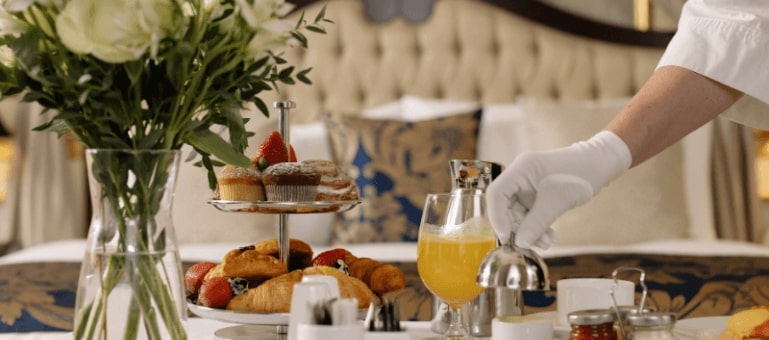
Room service brings the restaurant experience directly to a customer’s hotel room or accommodation. It’s a convenient and personalized way for guests to enjoy meals and refreshments without leaving the comfort of their rooms.
With room service, guests can order from a menu that offers a variety of dishes and beverages. The orders are then prepared by the hotel’s kitchen staff and delivered to the guest’s room at a time convenient for them.
This service is especially popular among travelers who prefer the convenience of dining in their rooms. It’s a way for hotels to provide an extra level of service and cater to the preferences of their guests.
Tray Service
It is a convenient dining option often found in settings like schools, hospitals, and large cafeterias. It simplifies the process of delivering meals to a diverse group of people efficiently. The hallmark of tray service is that each meal is pre-plated and assembled on a tray in the kitchen.
Typically, diners receive trays upon entering the dining area, and these trays contain everything needed for a complete meal, including a main course, sides, and beverages. This approach streamlines the serving process, making it faster and more convenient for both the customers and the establishment’s staff.
This special service is particularly popular in institutional settings where a quick, organized distribution of meals is essential. It ensures that everyone receives the same components in a consistent manner, helping maintain efficiency and quality control. Although it may lack the personal touch of other service styles, This service excels in delivering mass meals in an organized and efficient manner.
Home Delivery Service

With the proliferation of food delivery apps, home delivery services bring restaurant-quality meals to customers’ doorsteps.
Customers can place orders from their favorite local restaurants or fast-food chains through these platforms. Once the order is received, the restaurant prepares the food, and a delivery driver or courier service brings it directly to the customer’s doorstep. The entire process is designed for convenience, allowing people to enjoy a wide variety of cuisines without the need to dine out.
This special service has become a lifeline for restaurants, providing them with an additional source of revenue and access to a broader customer base. It’s a win-win situation for both diners and food establishments, offering the ease of enjoying restaurant-quality meals without leaving home.
Conclusion
Different types of services in food and beverage reflect the concepts of culinary diversity and personalized experience in the hospitality arena.
As we explored formal dining, casual & modern services, and specialized services, one thing became clear – dining is not just about eating but a celebration of flavors, preferences, and occasions.
Dining services are more than just preparing and delivering food; they showcase the dedication that defines the F&B industry.













